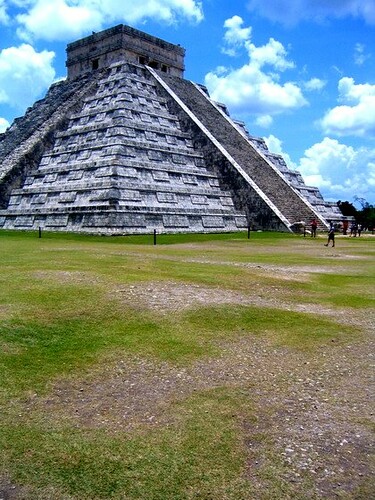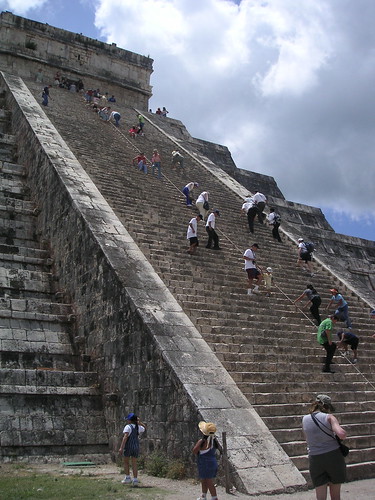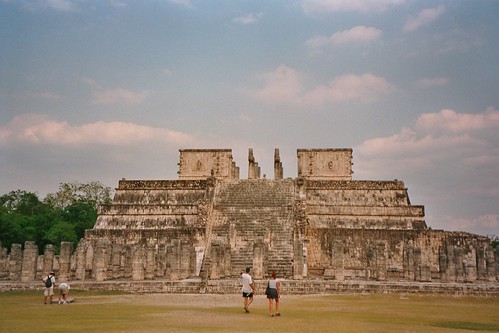The Castle or Pyramid of Kukulkan is the most impressive of Chichen Itza. Located in the middle of a large square, around which other magnificent buildings rise, and because of its proportions and design, you can admire a great distance. This building is a masterpiece of Maya-Toltec architecture.

Photography by kudumomo
The pyramid, which is supported by a square base of 55.5 meters wide, consists of nine terraced walls, whose decor is based on projections and rectangular panels. In the center of the four sides of the pyramid are deployed sumptuous stairs leading to the upper platform, where he built the temple.
The main staircase is located on the north side of the monument, and can be traced easily because the bottom of each one of the railings is a colossal head of a plumed serpent of stone. Head forms the base, body, trunk and tail, the capital. The vaulted chamber has two pillars, carved with figures of warriors, elegantly dressed, ornamentation is repeated on the jambs, also of Toltec style.

Photography by ewen and donabel
The porch overlooks a close gallery surrounding the temple, and also has access to the other three steps. At the top of the entrance is a mask of the god Chac and a frieze molding between two thick lines, which represent the god of rain, of the devotions of Quetzalcoatl.
The Castle was built in honor of Kukulcan, but some experts think it’s Maya monuments may have been built to worship the sun, since each of the stairs has 91 steps, which makes a total of 364 because there are four steps, plus another step they have the upper platform, total 365, which equals the number of days that contains a solar year. Each of the sides of the pyramid has 52 panels, exactly the same number of years the cycle comprising Toltec. The nine terraced walls, which includes the four sides of the monument, are divided by stairways, which includes the four sides of the monument, are divided by stairways, which gives a total of 18 sections, corresponding to 18 months of the Mayan calendar.
Within this construction, is another very similar. It is also a pyramid with a temple at the top and includes nine staggered walls. However, the ladder only has 61 steps and the sanctuary is much easier, as it consists only of an anteroom. The ornamentation of the walls of the façade reliefs based coiled snakes, tigers on the prowl, coats of arms and rosettes. It is quite possible that this building was one of the first built by the Toltec in the Yucatan Peninsula.
Some archaeologists found in the antechamber of the oldest temple, a Chac-Mool (meaning red claw, possibly messenger of the gods) inclined, the eyes, teeth, fingernails are inlaid with shells. And inside the sanctuary had a fierce jaguar throne-shaped mouth painted red with flecks figuring inlaid with jade discs, the eyes are also of jade and flint teeth. It is likely that the high priests have used this jaguar throne. On the seat was a beautiful gift, disc-shaped turquoise mosaics, beautifully carved. The entrance to the internal structure on the base of the north side of the pyramid outside.

Photography by sancho_panza
The equinox of the rattlesnake:
After several years of research, has concluded that the pyramid of Kukulkan was closely related to the equinoxes, and that as the Maya were expert astrologers and mathematicians, is likely to have built the pyramid for astronomical purposes.
By observing the effects that the sun’s rays on the pyramid, we can confirm that during the spring equinox (March 21) and autumn (September 22), around 3 o’clock, the sun is projected onto the main balustrade. This produces the effect of forming seven isosceles triangles, forming the undulating body of a serpent 34 feet long, which descends to join the huge stone head in the form of a serpent, at the foot of the stairs.
As a result, when the sun gets shadowed by terraced walls, pretending that the reptile is being moved. This phenomenon lasts about ten minutes, and as it is a great show, many people visit Chichén Itzá, year after year to have the opportunity to see it.
Bon voyage!
Leave a Reply
You must be logged in to post a comment.
Recent Comments